
| Palaeos: |  |
Glossary |
| The Vertebrates | Ch-Co |
| Page Back | Unit Back | Unit Home | Unit Dendrogram | Unit References | Glossary | Taxon Index |
| Page Next | Unit Next | Vertebrates Home | Vertebrate Dendrograms | Vertebrate References | Bones | Timescale |
For most phrases beginning with directional words, e.g. "posterior," "dorsal," "external," etc., or some generic anatomical terms, e.g., "vena," look under the next word in the phrase. However, note that this convention is not used with complete consistency in this Glossary.
Chandler Bridge Formation: Late Oligocene of North & South Carolina. Marine. Squalodont whales. Luo & Eastman (1995).
Chapadmalalan Age: South American Land Mammal Age corresponding to the Middle Pliocene (Piacenzian).
Chasicoan Age: South American Land Mammal Age corresponding to the Early Miocene.
Cheek teeth: molars. Actually, this term is used to avoid saying "molars," since that word refers to specialized, occluding, grinding teeth. Cheek teeth is more generic and simply refers to post-canine teeth, particularly in therapsids.
Chemosensory: relating to taste, smell, and other senses that operate directly on chemicals dissolved in the medium (air, water).
 Chevron:
[1] the Y-shaped bones on the underside of
caudal vertebrae in many archosaurs. The
image
shows chevrons from the tail of the tyrannosaurine Gorgosaurus.
Another example may be found at Earth
History Research Center; [2] Generally, the
hemal arches -- ventral projections of the vertebrae.
Chevron:
[1] the Y-shaped bones on the underside of
caudal vertebrae in many archosaurs. The
image
shows chevrons from the tail of the tyrannosaurine Gorgosaurus.
Another example may be found at Earth
History Research Center; [2] Generally, the
hemal arches -- ventral projections of the vertebrae.
Chiasm (var: "chiasma") Gr. chiasma = two crossing lines. Derived from the Greek letter chi which in Greek script was written 'X'.
Chiro-: Gr = hand
Chiropatagium: a flight membrane running between the fingers.
Chitarwata Formation: Early Oligocene of Pakistan. Terrestrial. Small mammals.
Choanae: choana Gr. choane = a funnel. Applied to the internal nares, i.e. nostrils that open into the oral cavity. Choanae are a character of derived sarcopterygians, including tetrapods.
Chondral Gr. chondros = cartilage.
Chondrocranium: The chondrocranium is sometimes called the neurocranium or endocranium and covers the ventral, lateral and posterior parts of the brain as well as closely related sensory structures. Development: the chondrocranium is formed by a combination of mesodermal sclerotome and neural crest cells. During development, cartilage forms around the brain beginning at the notochord. Sense organs are then surrounded by cartilage to form the optic capsules (for the eyes), nasal capsules (for the olfactory organs) and auditory capsules (for the ear, if present). In the posterior region of the chondrocranium the occipital arch develops, which is perforated by the foramen magnum to allow for passage of the spinal cord to the developing brain. Parts of the chondrocranium: the chondrocranium is most visible in more primitive species, such as the cartilaginous fishes. Specific regions, such as the rostrum, denotes the anterior portion of the cranium. The occipital condyle is in the posterior region of the chondrocranium and articulates with the notochord/vertebral column. In more advanced vertebrates, the chondrocranium is later ossified and becomes a more minor part of the skull. Introduction to the skeletal system.
Chorda Tympani: branch of the facial nerve that passes through the middle ear and conveys taste sensation from the anterior two-thirds of the tongue and carries fibers to the submandibular and sublingual salivary glands.
Chorion: the outer membrane of the amniotic egg.
Choroid Gr. chorion = skin, and eidos = resemblance; thus, skin-like.
Chucal Formation: Middle Miocene of northern Chile. River and lake deposits. Mammals (endemics and a very early chinchillid rodent). Flynn et al. (2002).
Cingulum: a ridge surrounding a tooth. pl. = cingula.
Circum-: L. circum = around, surrounding.
Cis-acting elements: DNA sequences in the vicinity of the structural portion of a gene that are required for gene expression, presumably by regulating the binding of regulatory proteins and RNA polymerases (trans-acting factors).
Clade: an organism and all of its descendants, i.e. a monophyletic group.
Cladodont: These teeth are characterized by a wide tooth base, a large central cusp and a variable number of lateral cusps. In cross-section the cusps are circular to somewhat D-shaped. See example and a bit more discussion at Crown Group. The OOK site also has a number of well-illustrated examples.
Clastic: Sediment consisting of broken fragments derived from preexisting rocks and transported elsewhere and redeposited before forming another rock. Examples of common clastic sedimentary rocks include siliciclastic rocks such as conglomerate, sandstone, siltstone and shale. Carbonate rocks can also be broken and reworked to form clastic sedimentary rocks.
 Clavicle:
in humans, the collar bone. The clavicle is part of the dermal shoulder
girdle. Typically in tetrapods, it braces the coracoid (or lower part of
the scapulocoracoid) laterally and/or ventrally and extends posteriorly as a
long rod. Anteriorly, it bends inward and articulates with the
interclavicle, if present, binding the two shoulder girdles together in a
flexible way. In most derived tetrapod lineages, the clavicle is reduced
and frequently disappears. However, it may become very large in flying and
swimming tetrapods. In these forms, the clavicle anchors part of the pectoralis
musculature, or its equivalent, which performs the power stroke in locomotion.
Clavicle:
in humans, the collar bone. The clavicle is part of the dermal shoulder
girdle. Typically in tetrapods, it braces the coracoid (or lower part of
the scapulocoracoid) laterally and/or ventrally and extends posteriorly as a
long rod. Anteriorly, it bends inward and articulates with the
interclavicle, if present, binding the two shoulder girdles together in a
flexible way. In most derived tetrapod lineages, the clavicle is reduced
and frequently disappears. However, it may become very large in flying and
swimming tetrapods. In these forms, the clavicle anchors part of the pectoralis
musculature, or its equivalent, which performs the power stroke in locomotion.
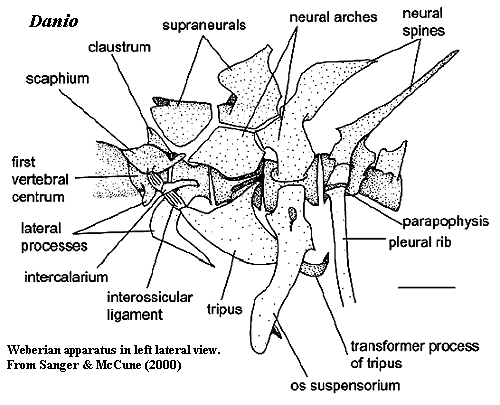 Claustrum: the last of the Weberian
ossicles in Otophysi.
The claustrum receives vibrations from the scaphium and, in turn, transmits
vibration to the perilymph of the sinus impar.
Claustrum: the last of the Weberian
ossicles in Otophysi.
The claustrum receives vibrations from the scaphium and, in turn, transmits
vibration to the perilymph of the sinus impar.
Clay: sediment particles less than 1/256th mm in diameter. See silt, sand, gravel.
Clear Fork Group: Lower(?) Permian of west & central Texas and Oklahoma, consists mostly of mudstone and shale with thin beds of limestone and dolomite. Deposits include flood plains and point bars deposited by small, variable-discharge, perennial streams with high sinuosity. untitled. "...the interval was deposited under hot and humid conditions in a complex array of specific environments ranging from nearshore marine, shoal, reef, and island complexes to lagoonal, tidal flat, and supratidal settings. Vegetal covering of island and supratidal areas was intermittently widespread. In the upper part of the Clear Fork, where peritidal and lagoonal facies dominate, solution collapse breccias testify to fresh water invasion during periods of sea level lowstand." [dead link]. Best known for remains of lepospondyls and synapsids (Tetraceratops, Varanops, sphenacodonts).
Clinoid process, posterior: a bony process of the sphenoid which projects dorsally and/or anteriorly from either side of the dorsum sellae.
Cloverly Formation: Early Cretaceous of Montana & Wyoming.
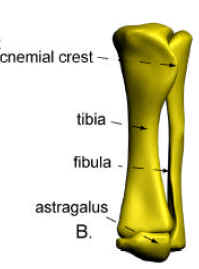 Cnemial:
relating to the tibia; tibial. The cnemial crest is a longitudinal
crest on the proximal part of the tibia, sometimes extending above the proximal
end of the shaft of the tibia.
Cnemial:
relating to the tibia; tibial. The cnemial crest is a longitudinal
crest on the proximal part of the tibia, sometimes extending above the proximal
end of the shaft of the tibia.
Coal Measures: Coal measures, generically, are the typical coal-bearing formation in which seams of coal, derived from the vegetation of lowland swamps, are separated by sediment resulting from periodic marine incursions. In British paleontology, the Lower, Middle and Upper Coal Measures refer to a periods corresponding to Westphalian stages A, B and C of the Late Carboniferous. The Lower and Middle Coal Measures map to the second half of the Bashkirian (~316- 311 Mya) and the Upper Coal Measures map to the first half of the Moscovian (311- ~306 Mya).
Coccyx Gr. kokkyx = cuckoo. A tube in the inner ear supporting the hair cells which transmit vibrations in the fluid of the ear to the brain. Adopted for anatomy from a supposed resemblance of this bone to the beak of a cuckoo. Actually, it looks more like a corkscrew. Unfortunately, the classicists who named this stuff drank wine right out of their ampullae, which would have been really confusing.
Cochlea: an elongated process of the lagena in the inner ear, associated with normal hearing in mammals. See The Ear.
Coelom: See Early Development Terms.
Coeval: of the same age; originating or existing during the same period of time.
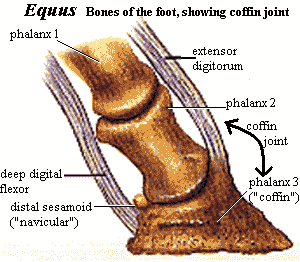 Coffin
Joint: in ungulates, the joint which rotates the distal phalanx ("coffin
bone") with respect to the middle phalanx.
Coffin
Joint: in ungulates, the joint which rotates the distal phalanx ("coffin
bone") with respect to the middle phalanx.
Colhuehuapian Age: South American Land Mammal Age corresponding to the Late Oligocene.
Columella: [1] same as the hyomandibula, stapes or epihyal. Used in reference to a slender derivative of the hyomandibula which extends from the tympanic membrane to the inner ear in tetrapods* other than mammaliforms. See Gill Arches and The Ear. [2] Any long, very thin portion of a bone, e.g. the columella of the epipterygoid which rises dorsally from the palate to the skull table.
Columnar: (of a cell layer) made up of elongated cells, as opposed to squamous or cuboidal.
Compound bone: a single postdentary bone created by fusion of the surangular, prearticular and articular. Characteristic of snakes.
Concha: (L. concha = seashell) a structure of the ethmoid also referred to as a turbinal or turbinate. The concha may or may not be ossified. It is typically made up of multiple layers of very thin, delicate bone or cartilage. The conchae may serve as an olfactory structure, or as a surface for the exchange of respiratory heat and water, depending on its location and the type of epithelium with which it is covered. In archosaurs and squamates, the concha tends to form a capsule surrounding olfactory tissue, the cavum conchae. In mammals, it tends to be a more open, layered structure. Thus the term concha is perhaps more appropriate for archosaurs, while turbinal or turbinate is more appropriate for mammals. See Ethmoid.
Condylar foramen, anterior: exit of the XIIth cranial (hypoglossal) nerve. Located just anterior to the occipital condyles, between the petrosal and exoccipitals, in mammaliforms.
Condyle: Gr. kondylos = a knuckle. The protruding element of a hinge, as the ball of a ball-and-socket joint or the pin of a hinge joint.
Condyloid process: of the dentary. The posterior process of the dentary which bears the dentary condyle in mammaliforms. See image at coronoid process.
Coniacian: an age of the Late Cretaceous, about 89.0-85.8 Mya.
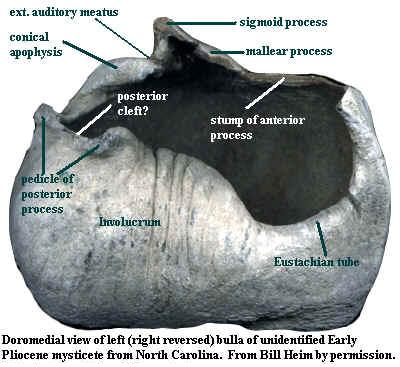 Conical
apophysis: a dorsal process of the bulla in whales which arises by a folding
of a medial process of the ectotympanic ring. The apophysis develops above
the external auditory meatus and tends to compress the meatus between the
apophysis and the sigmoid process.
Conical
apophysis: a dorsal process of the bulla in whales which arises by a folding
of a medial process of the ectotympanic ring. The apophysis develops above
the external auditory meatus and tends to compress the meatus between the
apophysis and the sigmoid process.
Conical recess: in the braincase and palate of basal tetrapods, particularly baphetids and temnospondyls, the pterygoid is notched near its articulation with the basipterygoid process of the braincase, at the base of the quadrate ramus. In part, this simple serves as an edge around which the basipterygoid process hooks to latch the palate to the braincase. It also leaves a small hole in the palate leading straight up into the braincase. This cavity is bordered by the pterygoid, the parasphenoid, and the braincase, and is located close to the basicranial articulation. It thus represents an unusually stable, strongly protected, and centrally-located cavity which may have housed a cartilaginous extension of the epipterygoid.
Contour feathers: the basic body feathers of a bird. Contour feathers often have a distal pennaceous region and a proximal plumaceous region.
Coprolite: fossilized shit.
Copula, basibranchial: see basibranchial.
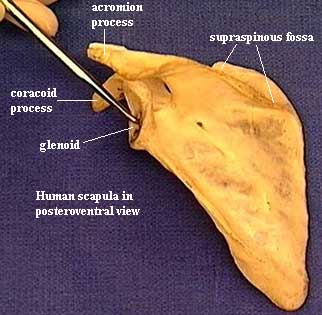 Coracoid
process: in mammals, the scapula and coracoid are fused. The
coracoid is therefore found as a process of the scapulocoracoid, generally
ventral to the glenoid. It anchors a number of muscles mostly relating to
movement of the humerus.
Coracoid
process: in mammals, the scapula and coracoid are fused. The
coracoid is therefore found as a process of the scapulocoracoid, generally
ventral to the glenoid. It anchors a number of muscles mostly relating to
movement of the humerus.
Cornus, cornua: lit. "horn"; any horn-like projection from the head area.
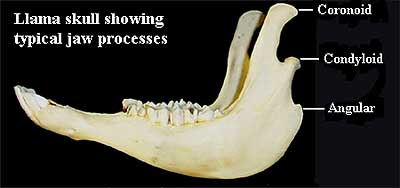 Coronoid
(emminence or process): a dorsal process on the lower jaw associated with muscle
attachment. It may be formed by a separate coronoid bone or as a process of the
dentary. In most living (and many extinct) mammals, the most dorsal of the three
proximal processes of the jaw.
Coronoid
(emminence or process): a dorsal process on the lower jaw associated with muscle
attachment. It may be formed by a separate coronoid bone or as a process of the
dentary. In most living (and many extinct) mammals, the most dorsal of the three
proximal processes of the jaw.
Cortical bone: generic term for the dense outer layer of bone found, particularly, on the outer surface of mammalian long bones. However, the term is far more general than this. It applies not only to periostial, lamellar, acellular bone, but to a variety of other bone types which may be cellular. Probably the common denominators are (a) lack of large internal spaces (cellular or otherwise) and (b) a network of parallel collagen (always?) fibers. More than one type of cortical bone may be present on any one "bone."
Cosmine: characteristic surface histology of many sarcopterygians and a few other groups. Continuous layer of dentine, covered by layer of enamel. Often pierced by numerous pores which open into (Ehrlenmeyer) flask-shaped cavities. The cavities are connected by canals (the "pore-canal system"). Enamel may or may not penetrate and cover all or a part of the inner surface of the pore cavity. The pore-canal system may have housed an electrosensory organ because the cavities and connecting canals resemble the ampullary canals of Lorenzini of sharks and the ampullary and tuberous organs of teleosts. This type of organ is especially useful in turbid water, where it can locate prey better than the eyes. It is also a system that still seems to be in use in the only living actinistian, the deep water marine Latimeria.
Cotyle: an articulation shaped as a round-bottom pit. Example: the blunt pit in the posterior braincase of lower vertebrates for articulation with the anterior notochord.
Cotyloid: cup-shaped.
Cotylus: same as a cotyle.
Cotype: A term not recognized by the ICZN, formerly used for either syntype or paratype, but that should not now be used in zoological nomenclature.
Covert: a feather or group of feathers which covers another structure, typically the rachis of a large flight or tail feather.
| Page Back | Unit Home | Page Top | Page Next |
checked ATW050803